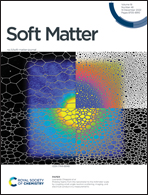Relaxation dynamics of deformed polymer nanocomposites as revealed by small-angle scattering and rheology
Abstract
The relaxation dynamics of polystyrene (PS)/silica nanocomposites after a large step deformation are studied by a combination of small-angle scattering techniques and rheology. Small-angle X-ray scattering measurements and rheology show clear signatures of nanoparticle aggregation that enhances the mechanical properties of the polymer nanocomposites (PNCs) in the linear viscoelastic regime and during the initial phase of stress relaxation along with accelerated relaxation dynamics. Small-angle neutron scattering experiments under the zero-average-contrast condition reveal, however, smaller structural anisotropy in the PNCs than that in the neat polymer matrix, as well as accelerated anisotropy relaxation. In addition, the degrees of anisotropy reduction and relaxation dynamics acceleration increase with increasing nanoparticle loading. These results are in sharp contrast to the prevailing viewpoint of enhanced molecular deformation as the main mechanism for the mechanical enhancement in PNCs. Furthermore, the observed acceleration of stress relaxation and reduction in structural anisotropy point to two types of nonlinear effects in the relaxation dynamics of PNCs at large deformation.



 Please wait while we load your content...
Please wait while we load your content...